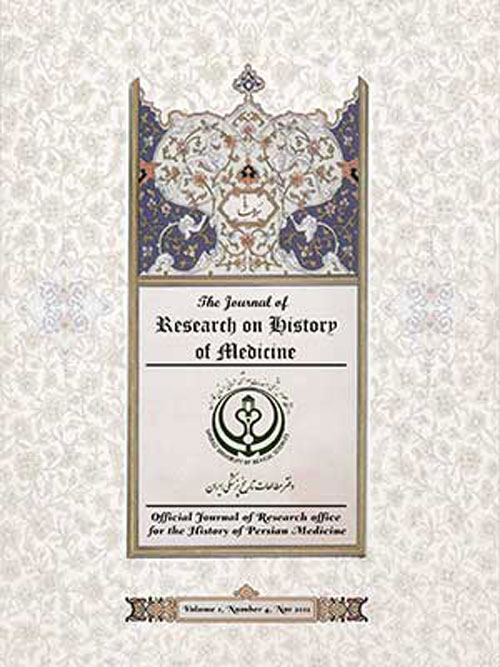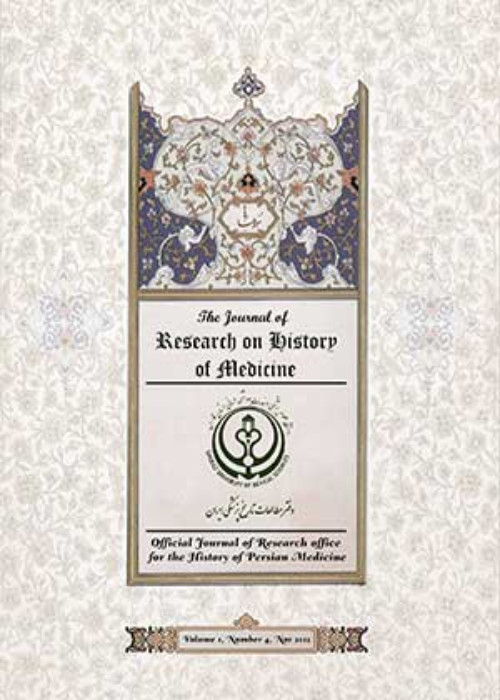فهرست مطالب

Journal of Research on History of Medicine
Volume:9 Issue: 2, May 2020
- تاریخ انتشار: 1399/04/29
- تعداد عناوین: 8
-
-
Pages 71-84For a long time, in different periods, Shiraz water was supplied from wells, aqueducts (qanat) and springs, which were generally open and hence got polluted in different ways on its way to the residential area. The consumption of these polluted waters resulted in the outbreak of infectious and contagious diseases, at times, killing a lot of people. Mohammad Namazi, having faced with the issue of unhealthy drinking water and consulted various specialists, found that the unsanitary drinking water was responsible for most gastrointestinal diseases as well as contagious diseases. In addition to constructing educational and health facilities, Namazi decided to develop a proper piping system for drinking water. At that time, even in the capital of Iran, there was not such a system. The present descriptive study, together with the library research method by scrutinizing local papers and newspapers, aims to first address the effect of the contaminated waters on the spread of contagious diseases and then the role of water piping system in reducing diseases in Shiraz. Research findings show that water supply and sanitation are important in reducing diseases such as typhoid, typhus, cholera and many waterborne diseases.Keywords: Water piping system, Disease Outbreaks, Shiraz, Typhoid Fever, Typhus, Cholera
-
Pages 85-94Ancient Iranians are among the nations well aware of the therapeutic effects of herbs, and hence pharmacology, even though no written scientific text is left giving witness to this. However, in mythical as well as ancient stories, one can find traces of the familiarity of ancient people with medicine and treatment. However, after the emergence of Islam (6 A.D.), numerous textbooks on the pharmacy science (pharmaceutical science) are available. These texts, along with other historical and literary texts, encompass traces testifying the existence of such traditional pharmacies. Such pharmacies were in practice till mid-19th century when the first medical school was launched. At this time, mainly due to the familiarity of Naseredin Shah, (the King), with medical improvement in Europe, the first modern medical school was established in Iran. A French doctor, Dr. Focckette, as the first pharmacy teacher, started working in this school. This was followed by the effort made by Albert Scheverin, a Dutchman, to found the first modern pharmacy in Tehran, in 1882, providing people with chemical medicine. The present study aimed at giving a report on the history of medicine and pharmacy in Iran, followed by the reports of the first modern pharmacies founded in Iran.Keywords: Pharmaceutical Services, Pharmacy, Modern pharmacies, Pharmacy teacher, Iran, Attari
-
Pages 95-102Ikhtiyarat Badiei is a well-written book authored by Haji Zain al Din Ansari (15th AD) in the era of Mozaffarid dynasty in Shiraz. The main tenet of the book is to introduce plant, animal and inanimate drugs in an alphabetical order. In this book, the writer has talked about the ancient terms used for drugs and medications. In addition, in writing the book, he has given reference to all related works used. Basically, the present study is a library research using the descriptive method and its main aim is to investigate the strong and weak points of Ikhtiyarat Badiei, as one of the most important books on pharmacology written in Persian in the Islamic era in the 15th century.Keywords: Islamic era medicine, Islamic era pharmacology, Drugs, Haji Zain al Din Ansari, Ikhtiyarat Badiei, Books, Writing, Libraries
-
Pages 103-110This study deals with how the Austrian physician, Sigmund Freud, was perceived as a psychotherapist and scientist in pre-revolutionary Iran. The opinions voiced by the Persian critics, authors, and translators in the period under discussion reveals an approach informed by authentic culture or domestically originated thinking and assertions that substantiate the claim that Persian scholars and authors had already touched upon or even elaborated on the concepts brought up by Freud. The study indicates that authors and translators dealing with Freudian ideas are interested in understanding Freud by adopting an “imperialistic” approach in terms of discourse importation theories. Moreover, his discourse is co-opted as a scientific one in the period under discussion. This study may serve as a contribution to history of medicine in Iran – not least, that of psychotherapy – and can indicate how the evolution of a school of thought takes place when it is implanted in or imported to a new context.Keywords: Iran, Psychotherapy, Authentic culture, Freud, Therapeutic
-
Pages 111-122At the beginning of the Qajar era, Iran’s relationship with the West created the ground for political, social and cultural developments. One of the most important advantages was that Iran’s relations with the West led to the introduction of new ideas and approaches in the field of medicine and health in Iran. At that time, the low-quality healthcare and medical services provided in Iran, compared with the development in Western medical sciences attracted the attention of some Qajar periodicals and journals. One of these journals was Ganjineh-e-Fonoon, which devoted itself mostly to publishing articles on the progress made in medical and health issues. This periodical was first published before the Constitution Movement in Tabriz. An examination of the articles published in Ganjineh-e-Fonoon showed that while most articles welcomed modern medicine, they challenged the credibility of traditional medicine. Regarding this, it can be claimed that this journal, as one of the influential periodicals of the day, played an important role in informing and helping people in their transition from relying on traditional medicine to modern medicine. The present study is a library research which has employed a descriptive approach in the analysis of the data collected.Keywords: Ganjineh-e-Fonoon, Qajar, Health, Medicine, Social Change
-
Pages 123-154The current study employed corpus linguistics techniques in order to shed light on the representation of “cholera”, “measles”, and “plague” over 19th and 20th centuries in American society. To this end and also to compare the representation of the mentioned contagious diseases over time, the current study explored how these target words (i.e., cholera, measles and plague) in texts of 19th and 20th centuries collocate with other words. To study the collocation patterns of contagious diseases over time, corpus of historical American English (COHA) was used. The results indicated that language change represented the events taken place in the society. Moreover, as expected, it was revealed that the texts on different diseases (i.e., cholera, measles, and plague) carried over a negative prosody. Regarding the difference between the 19th and 20th centuries, although the frequency of the target words in the 19th and 20th centuries were not equal, the collocational patterns of these contagious diseases over 19th and 20th centuries were almost similar.Keywords: Collocation patterns, Representation of contagious diseases, Cholera, Measles, Plague, Corpus of historical American English (COHA)


